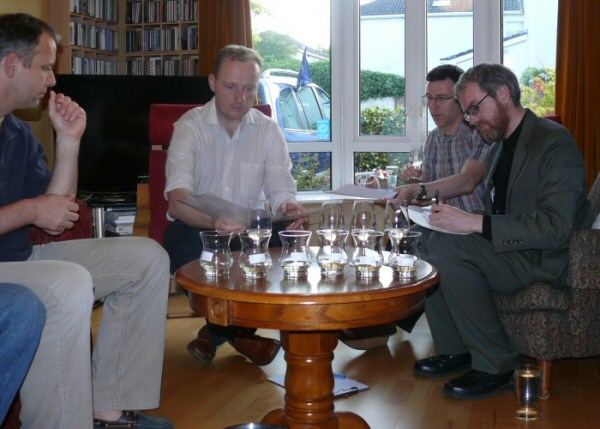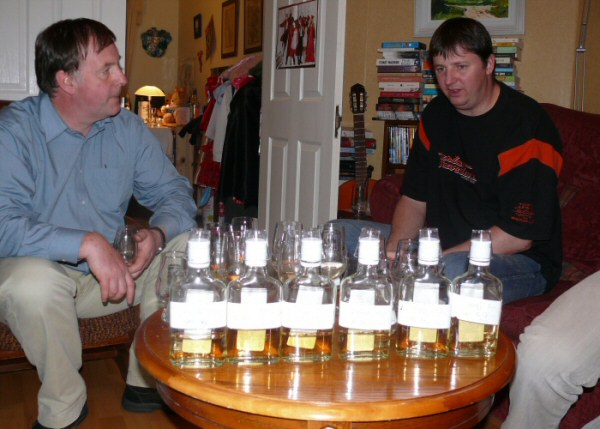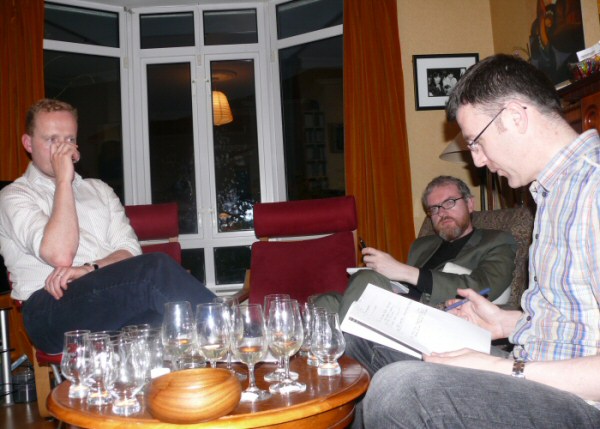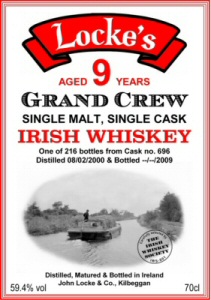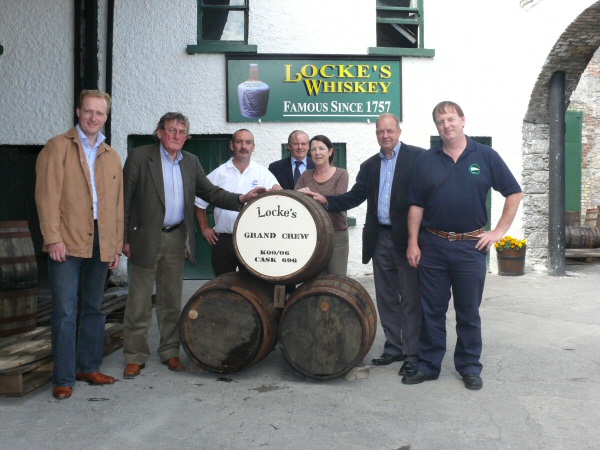NOTE: This forum is no longer active. This is an archive copy of the forum as it was on 10 March 2018.
Irish Whiskey Society first cask bottling
91 posts
• Page 1 of 4 • 1, 2, 3, 4
Irish Whiskey Society first cask bottling
Some people may be aware that the Irish Whiskey Society is teaming up with the Inland Waterways Association of Ireland and the Heritage Boat Association to bottle its first cask later this year.
The bottling, known as the 'Grand Crew', will make history later this Summer when it is brought down the Grand Canal from the distillery at Kilbeggan to Dublin, the first time whiskey has been transported by boat down the canal in over half a century.
IWS member and IWAI member Michael Slevin is the man who has been at the fulcrum of the project and brought all the elements together to make this happen. And so it was fitting that when it came time to decide on a cask to bottle, the tasting committee gathered in his home to do so.
On behalf of the Society, six of the board gathered at the home of Michael Slevin to assess six different casks from Cooley with a view to bottling one as the 'Grand Crew' bottling specially selected by the Irish Whiskey Society.
The nosing and tasting was conducted blind, but tasters were aware that there were three 8 year old casks and 3 9 year old casks.
It quickly became evident that the first three casks were the younger three. After tasting was complete, it was revealed that the casks were in chronological order of distillation and in fact were almost consecutive casks in Cooley's warehouse.
The casks were:
(1) K01/1 no. 57, an 8yo
(2) K01/1 no. 60, an 8yo
(3) K01/1 no. 61, an 8yo
(4) K00/6 no. 696 - 9yo
(5) K00/6 no. 697 - 9yo
(6) K00/6 no. 700 - 9yo
As Michael Slevin has noted, despite this near sequentiality, there was significant variety among the samples.
They were nosed firstly at 20% and then again at 40%, before being tasted at c. 40-50% and again at cask strength.
A consensus soon developed that three were superior to the remainder. These three were:
(3) K01/1 no. 61
(4) K00/6 no. 696
(6) K00/6 no. 700
Nosing at 20%:
Sample (1) showed some typical Tyrconnell fruitiness, a little green apple and sweetness but was otherwise sugary and fiery on the nose.
Sample (2) appeared to be quite bland, indicating some pear and grapeskin on the nose.
Sample (3) offered vanilla pod, some pepperiness, as well as the light fruitiness familiar from Tyrconnell.
Sample (4) had a fascinating nose, quite floral with hints of peach, apricot and lemongrass, as well as some grassiness.
Sample (5) was somewhat maltier than others, offering grain and some grass on the nose.
Sample (6) was complex on the nose, offering some citrus notes, leafiness and fruity acetic acid.
Nosing at 40% largely confirmed the above opinions, with the three favoured samples offering up some further top notes.
Sample (3) offered more citrus and grain at 40%, while sample (4) offered bananas and cut pear, and sample (6) offered some leather.
Tasting was conducted in two formal rounds at different strengths. In the first round, tasting was conducted at between 40% and 50% proof depending on taster's preference. A second round of tasting was conducted at between 50% and cask strength again dependent on taster's preference.
Despite three clear favourites from the nosing, we tasted all six samples carefully. However, the same three samples came to the fore.
Sample (1) was fruity, apply and very fiery, certainly too young and rough to bottle.
Sample (2) was oilier and grassier, somewhat more rounded but still young and unremarkable.
Sample (3) was pleasant, light and balanced, with good fruit and an impactful lengthy finish
Sample (4) offered an interesting if somewhat unbalanced array of exotic fruits, peaches, apricots, dried pear, almonds, grassiness and some malt. While fascinating, it did die somewhat quickly on the finish, however.
Sample (5) came across quite citric, with some mild malt and another shortened finish.
Sample (6) offered some pepper, apple pie, nuts and pear drops as well as a pleasant oiliness and a malty finish.
Debate soon centred upon the two older preferred samples, (4) and (6), casks 696 and 700 respectively. Both had their fans and all agreed that these two samples were the best two in the entire range we had received.
At this point, the six tasters present consulted with Adrian Phelan by telephone. Adrian had come to remarkably similar conclusions on his own, having considered all of the samples alone on a previous date.
After votes were cast, there was a very marginal preference for the somewhat unusual sample (4) – cask 696, over the more conventional sample (6) – cask 700.
Therefore, after nearly four hours of tasting, it was decided by the most narrow of margins to bottle cask number 696 as the 'Grand Crew' bottling, the first ever whiskey specially selected by the Irish Whiskey Society.
Limited numbers of bottles of this 'Grand Crew' will be available for purchase by IWS members later in the year.
The bottling, known as the 'Grand Crew', will make history later this Summer when it is brought down the Grand Canal from the distillery at Kilbeggan to Dublin, the first time whiskey has been transported by boat down the canal in over half a century.
IWS member and IWAI member Michael Slevin is the man who has been at the fulcrum of the project and brought all the elements together to make this happen. And so it was fitting that when it came time to decide on a cask to bottle, the tasting committee gathered in his home to do so.
On behalf of the Society, six of the board gathered at the home of Michael Slevin to assess six different casks from Cooley with a view to bottling one as the 'Grand Crew' bottling specially selected by the Irish Whiskey Society.
The nosing and tasting was conducted blind, but tasters were aware that there were three 8 year old casks and 3 9 year old casks.
It quickly became evident that the first three casks were the younger three. After tasting was complete, it was revealed that the casks were in chronological order of distillation and in fact were almost consecutive casks in Cooley's warehouse.
The casks were:
(1) K01/1 no. 57, an 8yo
(2) K01/1 no. 60, an 8yo
(3) K01/1 no. 61, an 8yo
(4) K00/6 no. 696 - 9yo
(5) K00/6 no. 697 - 9yo
(6) K00/6 no. 700 - 9yo
As Michael Slevin has noted, despite this near sequentiality, there was significant variety among the samples.
They were nosed firstly at 20% and then again at 40%, before being tasted at c. 40-50% and again at cask strength.
A consensus soon developed that three were superior to the remainder. These three were:
(3) K01/1 no. 61
(4) K00/6 no. 696
(6) K00/6 no. 700
Nosing at 20%:
Sample (1) showed some typical Tyrconnell fruitiness, a little green apple and sweetness but was otherwise sugary and fiery on the nose.
Sample (2) appeared to be quite bland, indicating some pear and grapeskin on the nose.
Sample (3) offered vanilla pod, some pepperiness, as well as the light fruitiness familiar from Tyrconnell.
Sample (4) had a fascinating nose, quite floral with hints of peach, apricot and lemongrass, as well as some grassiness.
Sample (5) was somewhat maltier than others, offering grain and some grass on the nose.
Sample (6) was complex on the nose, offering some citrus notes, leafiness and fruity acetic acid.
Nosing at 40% largely confirmed the above opinions, with the three favoured samples offering up some further top notes.
Sample (3) offered more citrus and grain at 40%, while sample (4) offered bananas and cut pear, and sample (6) offered some leather.
Tasting was conducted in two formal rounds at different strengths. In the first round, tasting was conducted at between 40% and 50% proof depending on taster's preference. A second round of tasting was conducted at between 50% and cask strength again dependent on taster's preference.
Despite three clear favourites from the nosing, we tasted all six samples carefully. However, the same three samples came to the fore.
Sample (1) was fruity, apply and very fiery, certainly too young and rough to bottle.
Sample (2) was oilier and grassier, somewhat more rounded but still young and unremarkable.
Sample (3) was pleasant, light and balanced, with good fruit and an impactful lengthy finish
Sample (4) offered an interesting if somewhat unbalanced array of exotic fruits, peaches, apricots, dried pear, almonds, grassiness and some malt. While fascinating, it did die somewhat quickly on the finish, however.
Sample (5) came across quite citric, with some mild malt and another shortened finish.
Sample (6) offered some pepper, apple pie, nuts and pear drops as well as a pleasant oiliness and a malty finish.
Debate soon centred upon the two older preferred samples, (4) and (6), casks 696 and 700 respectively. Both had their fans and all agreed that these two samples were the best two in the entire range we had received.
At this point, the six tasters present consulted with Adrian Phelan by telephone. Adrian had come to remarkably similar conclusions on his own, having considered all of the samples alone on a previous date.
After votes were cast, there was a very marginal preference for the somewhat unusual sample (4) – cask 696, over the more conventional sample (6) – cask 700.
Therefore, after nearly four hours of tasting, it was decided by the most narrow of margins to bottle cask number 696 as the 'Grand Crew' bottling, the first ever whiskey specially selected by the Irish Whiskey Society.
Limited numbers of bottles of this 'Grand Crew' will be available for purchase by IWS members later in the year.
Last edited by jcskinner on Thu Jun 18, 2009 2:16 pm, edited 1 time in total.
- jcskinner
- Bourbon Barrel
- Posts: 462
- Joined: Sun Mar 29, 2009 2:19 pm
Re: Irish Whiskey Society first cask bottling
Muileann muilte Dé go mall, ach muileann siad go mín. (That is to say the mills of God grind slowly but finely, i.e. the society was a long time coming but it was inevitable).
I thought the mechanical tones of the seanfhocal suited this astonishing news. How quickly the cogs and so on have moved to bring us to this point! I must say my congratulations to all the members and organisers who have worked so hard for this and I look forward to getting a bottle of this when it becomes available.
I thought the mechanical tones of the seanfhocal suited this astonishing news. How quickly the cogs and so on have moved to bring us to this point! I must say my congratulations to all the members and organisers who have worked so hard for this and I look forward to getting a bottle of this when it becomes available.
- cathach
- Rundlet Cask
- Posts: 115
- Joined: Mon Mar 23, 2009 8:08 pm
Re: Irish Whiskey Society first cask bottling
I hope it wasn't too mechanical, Cathach!
I justed wanted to convey the fact that this was done extremely methodically and thoroughly. No cask was ever chosen with more care or attention, I suspect!
From what I recall, it's a fascinating wee dram that will reward tipplers who get to try it, and has a little bit more going on than your average Tyrconnell.
We're still a long way back from bottling, selling or tasting at this time, but all of that will come to pass in the next few months, and I thought it would be valuable to share with the members what stage in the process things had reached.
I justed wanted to convey the fact that this was done extremely methodically and thoroughly. No cask was ever chosen with more care or attention, I suspect!
From what I recall, it's a fascinating wee dram that will reward tipplers who get to try it, and has a little bit more going on than your average Tyrconnell.
We're still a long way back from bottling, selling or tasting at this time, but all of that will come to pass in the next few months, and I thought it would be valuable to share with the members what stage in the process things had reached.
- jcskinner
- Bourbon Barrel
- Posts: 462
- Joined: Sun Mar 29, 2009 2:19 pm
Re: Irish Whiskey Society first cask bottling
A thorough, controlled process, conducted in a formal fashion and properly validated. I'm sure it was a pleasure to be involved but still an important and pressure-filled job - given that the Society's name will be on the eventual bottle. Well done to all involved and many thanks for work done to date. Looking forward to tasting the premier release!
John.
John.
Always carry a flagon of whiskey in case of snakebite and furthermore; always carry a small snake - W.C. Fields et al.
-

John - Hogshead
- Posts: 641
- Joined: Tue Mar 24, 2009 1:32 pm
- Location: Dublin Mountains!
Re: Irish Whiskey Society first cask bottling
I was lucky enough to have a taste too but was not as clinical in my methods.
It was very obvious that all these were from the Tyrconell side of the warehouse so I ignored the Tyrconnell fruitiness that was evident in them in one degree or another.
Eventhough I had the exact same first and second as the tenacious taste team I had actually dismissed 1-3 and I found them much lighter than 4-6. I was also tasting at cask strength and touched them with water after a while. SO slightly different from the main crew.
I placed No 4 first with No 6 second.
Sample No 4
A wonderfully more heavier nose that any the 3 previous. Malt enveloped by sweet floral notes (but not perfumed) and followed by muted dry grass.
Quite oily and thick on the palate with some lovely fresh fruits (mango etc).
Followed by Big wood spice burst at the end (Probably the pepper Brian Quinn mentions)
Sample No 6.
This had the heaviest malt nose for me with nut and plenty of fruit with a slightly fruity vinegar in the back ground.
Probably out of them all this had the most obvious Tyrconnell fruitiness on the taste. Then a welcome sour note balancing the sweet fruit
It was very obvious that all these were from the Tyrconell side of the warehouse so I ignored the Tyrconnell fruitiness that was evident in them in one degree or another.
Eventhough I had the exact same first and second as the tenacious taste team I had actually dismissed 1-3 and I found them much lighter than 4-6. I was also tasting at cask strength and touched them with water after a while. SO slightly different from the main crew.
I placed No 4 first with No 6 second.
Sample No 4
A wonderfully more heavier nose that any the 3 previous. Malt enveloped by sweet floral notes (but not perfumed) and followed by muted dry grass.
Quite oily and thick on the palate with some lovely fresh fruits (mango etc).
Followed by Big wood spice burst at the end (Probably the pepper Brian Quinn mentions)
Sample No 6.
This had the heaviest malt nose for me with nut and plenty of fruit with a slightly fruity vinegar in the back ground.
Probably out of them all this had the most obvious Tyrconnell fruitiness on the taste. Then a welcome sour note balancing the sweet fruit
- IrishWhiskeyChaser
- Site Admin
- Posts: 2910
- Joined: Tue Mar 17, 2009 1:37 pm
- Location: A Dark Dunnage somewhere in Galway
Re: Irish Whiskey Society first cask bottling
Apologies for the delay herewith some photos from the selection night, May 29th, 2009.
We started off bright and early ... and very eager.
and we stuck to the task.
As Jim said above - a lot of thought and discussion and not a little expertise went into the selection.
Michael
We started off bright and early ... and very eager.
and we stuck to the task.
As Jim said above - a lot of thought and discussion and not a little expertise went into the selection.
Michael
-

PureDrop - Rundlet Cask
- Posts: 185
- Joined: Tue Apr 07, 2009 2:36 pm
Re: Irish Whiskey Society first cask bottling
OK, we've progressed the project a fair bit.
As above, this is a joint effort with the Inland Waterways Association of Ireland and the Heritage Boat Association. Cooley have been very supportive of this bottling as it marks a significant event in the life of the Irish Inland Waterways, namely the 50th anniversary of the withdrawal of the commercial canal boats by CIE in 1959. Given the importance of the canal system to the success of Locke's Distillery in the 2nd half of the 19th century, it is natural that Cooley would support this venture. Nonetheless, we thank them for all the assistance given us to date. Andrew Bielenberg's book "Locke's Distillery, A History" is recommended reading.
For more information on the background, the rationale and indeed the whiskey, please see http://grandcrew.iwai.ie/
We're looking forward to getting the cask to Dublin and sampling the contents (again).
Michael
Again, more information at http://grandcrew.iwai.ie/
As above, this is a joint effort with the Inland Waterways Association of Ireland and the Heritage Boat Association. Cooley have been very supportive of this bottling as it marks a significant event in the life of the Irish Inland Waterways, namely the 50th anniversary of the withdrawal of the commercial canal boats by CIE in 1959. Given the importance of the canal system to the success of Locke's Distillery in the 2nd half of the 19th century, it is natural that Cooley would support this venture. Nonetheless, we thank them for all the assistance given us to date. Andrew Bielenberg's book "Locke's Distillery, A History" is recommended reading.
For more information on the background, the rationale and indeed the whiskey, please see http://grandcrew.iwai.ie/
We're looking forward to getting the cask to Dublin and sampling the contents (again).
Michael
Again, more information at http://grandcrew.iwai.ie/
Last edited by PureDrop on Thu Jul 16, 2009 12:57 am, edited 1 time in total.
-

PureDrop - Rundlet Cask
- Posts: 185
- Joined: Tue Apr 07, 2009 2:36 pm
Re: Irish Whiskey Society first cask bottling
And Michael ... I think you can take a big bow too ... as with out your enthusiasm this would never have seen light of day. I for one think it is great to see people who are passionate about their own loves and encompas other passions  ... okay maybe your equally passionate about both but that makes you twice the man
... okay maybe your equally passionate about both but that makes you twice the man 
By the way who are all those idiots in the pics
By the way who are all those idiots in the pics
Sláinte Adrian
- IrishWhiskeyChaser
- Site Admin
- Posts: 2910
- Joined: Tue Mar 17, 2009 1:37 pm
- Location: A Dark Dunnage somewhere in Galway
Re: Irish Whiskey Society first cask bottling
they are the Grand Crew Whiskey tasters 
IrishWhiskeyChaser wrote:And Michael ... I think you can take a big bow too ... as with out your enthusiasm this would never have seen light of day. I for one think it is great to see people who are passionate about their own loves and encompas other passions... okay maybe your equally passionate about both but that makes you twice the man
By the way who are all those idiots in the pics
Happiness is having a rare steak,a bottle of whiskey, and a dog to eat the rare steak!!!
-

varizoltan - Fully mature Cask
- Posts: 1023
- Joined: Fri Mar 20, 2009 11:03 pm
- Location: Hungary
Re: Irish Whiskey Society first cask bottling
...and they were hard at it... 
IrishWhiskeyChaser wrote:And Michael ... I think you can take a big bow too ... as with out your enthusiasm this would never have seen light of day. I for one think it is great to see people who are passionate about their own loves and encompas other passions... okay maybe your equally passionate about both but that makes you twice the man
By the way who are all those idiots in the pics
Happiness is having a rare steak,a bottle of whiskey, and a dog to eat the rare steak!!!
-

varizoltan - Fully mature Cask
- Posts: 1023
- Joined: Fri Mar 20, 2009 11:03 pm
- Location: Hungary
Re: Irish Whiskey Society first cask bottling
Again, great work guys. It's good to see it all coming together.
J.
J.
Always carry a flagon of whiskey in case of snakebite and furthermore; always carry a small snake - W.C. Fields et al.
-

John - Hogshead
- Posts: 641
- Joined: Tue Mar 24, 2009 1:32 pm
- Location: Dublin Mountains!
Re: Irish Whiskey Society first cask bottling
The official photo-op!
... with reps of the Irish Whiskey Society, 107B Restoration barge Project, Heritage Boat Association, Kilbeggan Harbour Amenity Group, Cooley Distillery, and the Inland Waterways Association of Ireland at Locke's of Kilbeggan. Most people in the group wear multiple hats, one person is associated with all but one of the above entities.
... with reps of the Irish Whiskey Society, 107B Restoration barge Project, Heritage Boat Association, Kilbeggan Harbour Amenity Group, Cooley Distillery, and the Inland Waterways Association of Ireland at Locke's of Kilbeggan. Most people in the group wear multiple hats, one person is associated with all but one of the above entities.
-

PureDrop - Rundlet Cask
- Posts: 185
- Joined: Tue Apr 07, 2009 2:36 pm
Re: Irish Whiskey Society first cask bottling
Well Done Gents!
Looking forward to a sample...
Looking forward to a sample...
- Luke Gough
- Bourbon Barrel
- Posts: 412
- Joined: Fri Mar 27, 2009 3:28 pm
- Location: Dublin City
Re: Irish Whiskey Society first cask bottling
This really is very inspiring. Congratulations to Michael for showing us all what's possible. I'm sure it's only a matter of time before he moves from filling bottles to filling the canal.
-

DavidH - Fully mature Cask
- Posts: 1280
- Joined: Tue Mar 17, 2009 7:49 pm
- Location: Dublin
Re: Irish Whiskey Society first cask bottling
DavidH wrote:This really is very inspiring. Congratulations to Michael for showing us all what's possible. I'm sure it's only a matter of time before he moves from filling bottles to filling the canal.
That would be a real waste of whiskey though
Sláinte Adrian
- IrishWhiskeyChaser
- Site Admin
- Posts: 2910
- Joined: Tue Mar 17, 2009 1:37 pm
- Location: A Dark Dunnage somewhere in Galway
Re: Irish Whiskey Society first cask bottling
Some good coverage in today's Irish Times (page 2) http://www.irishtimes.com/newspaper/ireland/2009/0810/1224252313895.html
-

PureDrop - Rundlet Cask
- Posts: 185
- Joined: Tue Apr 07, 2009 2:36 pm
Re: Irish Whiskey Society first cask bottling
MichaelS wrote:Some good coverage in today's Irish Times (page 2) http://www.irishtimes.com/newspaper/ireland/2009/0810/1224252313895.html
Excellent coverage Michael ...
I see that it says it is going to happen in August which is this month.
When is the official date for the fateful journey?
I should of thought of it before but this would be an excellent article for Nation Wide but probably too late to organise now
Sláinte Adrian
- IrishWhiskeyChaser
- Site Admin
- Posts: 2910
- Joined: Tue Mar 17, 2009 1:37 pm
- Location: A Dark Dunnage somewhere in Galway
Re: Irish Whiskey Society first cask bottling
They mentioned it on Seascapes on RTE Radio 1 a few weeks ago.
- JohnM
- Fully mature Cask
- Posts: 1634
- Joined: Wed Mar 18, 2009 9:02 pm
Re: Irish Whiskey Society first cask bottling
The "Grand Crew" should feature on Newstalk 106 today at 15:15ish on the Sean Moncrieff show - Listen Live on http://newstalk.ie/newstalk/listen-live-now.html
... and to answer the question posed above.
It is proposed to shift the casks on Saturday August 29th - more specific details will be posted to http://www.grandcrew.iwai.ie/index.html#Timings.
/M
... and to answer the question posed above.
It is proposed to shift the casks on Saturday August 29th - more specific details will be posted to http://www.grandcrew.iwai.ie/index.html#Timings.
/M
-

PureDrop - Rundlet Cask
- Posts: 185
- Joined: Tue Apr 07, 2009 2:36 pm
Re: Irish Whiskey Society first cask bottling
Fellow members.
We are naturally invited to participate in the shipping of the casks from Kilbeggan to Ballycommon on Saturday 29th August. Not sure what form this might take - however we might have responsibility for defending the casks for a mile or so of its 8-mile journey from Kilbeggan to Balllycommon. Alternatively, we might of course decide that these boaty types don't deserve to keep any of this whiskey and launch an ambush. Alternatively (again), if someone had access to a suitable vintage truck, we might take responsibility for the 1st mile of the journey from the distillery to Kilbeggan Harbour by road.
If anyone would like to participate in any shenanigans on the day or especially has access to a suitable vintage vehicle, give us a shout off-list to grandcrew AT irishwhiskeysociety.com
/Michael
We are naturally invited to participate in the shipping of the casks from Kilbeggan to Ballycommon on Saturday 29th August. Not sure what form this might take - however we might have responsibility for defending the casks for a mile or so of its 8-mile journey from Kilbeggan to Balllycommon. Alternatively, we might of course decide that these boaty types don't deserve to keep any of this whiskey and launch an ambush. Alternatively (again), if someone had access to a suitable vintage truck, we might take responsibility for the 1st mile of the journey from the distillery to Kilbeggan Harbour by road.
If anyone would like to participate in any shenanigans on the day or especially has access to a suitable vintage vehicle, give us a shout off-list to grandcrew AT irishwhiskeysociety.com
/Michael
Last edited by PureDrop on Mon Aug 10, 2009 10:37 pm, edited 1 time in total.
-

PureDrop - Rundlet Cask
- Posts: 185
- Joined: Tue Apr 07, 2009 2:36 pm
Re: Irish Whiskey Society first cask bottling
I'm Gutted ... I've plans for that week-end 
Ahh well ... just as long as I can get my hands on a couple of bottles I'll be happy, if not a couple of each
Well Michael I wish you all the best of luck on this great endeavour of yours and hope ye have a great day.
Ahh well ... just as long as I can get my hands on a couple of bottles I'll be happy, if not a couple of each
Well Michael I wish you all the best of luck on this great endeavour of yours and hope ye have a great day.
Sláinte Adrian
- IrishWhiskeyChaser
- Site Admin
- Posts: 2910
- Joined: Tue Mar 17, 2009 1:37 pm
- Location: A Dark Dunnage somewhere in Galway
Re: Irish Whiskey Society first cask bottling
Fair play lads.
It's really great to see this developing to this extent and a real feather in the cap for the Society especially given how long we are in existence.
John.
It's really great to see this developing to this extent and a real feather in the cap for the Society especially given how long we are in existence.
John.
Always carry a flagon of whiskey in case of snakebite and furthermore; always carry a small snake - W.C. Fields et al.
-

John - Hogshead
- Posts: 641
- Joined: Tue Mar 24, 2009 1:32 pm
- Location: Dublin Mountains!
Re: Irish Whiskey Society first cask bottling
i am going away on 28th 
Happiness is having a rare steak,a bottle of whiskey, and a dog to eat the rare steak!!!
-

varizoltan - Fully mature Cask
- Posts: 1023
- Joined: Fri Mar 20, 2009 11:03 pm
- Location: Hungary
Re: Irish Whiskey Society first cask bottling
Kaixo Chico's,
Please remember yer pool aul thirsty Pilgrim and Whiskey-Geese expat in the Basque Country when bottling Grand Crew as i would love a bottle or two.......when will ye be bottling this expression ???
Agur/Adios/Slain agus Slainte !!
Please remember yer pool aul thirsty Pilgrim and Whiskey-Geese expat in the Basque Country when bottling Grand Crew as i would love a bottle or two.......when will ye be bottling this expression ???
Agur/Adios/Slain agus Slainte !!
Whiskey Pilgrim, "Cock o´Bizkaia"!!
-

Whiskey Pilgrim - Rundlet Cask
- Posts: 102
- Joined: Mon Mar 23, 2009 8:23 pm
- Location: Gernika Bizkaia (Euskadi)Basque Region, Spain
Re: Irish Whiskey Society first cask bottling
Finished bottles likely to be available in October or so. No rush just yet. At the moment the cask(s) have yet to even travel down the canal.
- jcskinner
- Bourbon Barrel
- Posts: 462
- Joined: Sun Mar 29, 2009 2:19 pm
91 posts
• Page 1 of 4 • 1, 2, 3, 4

